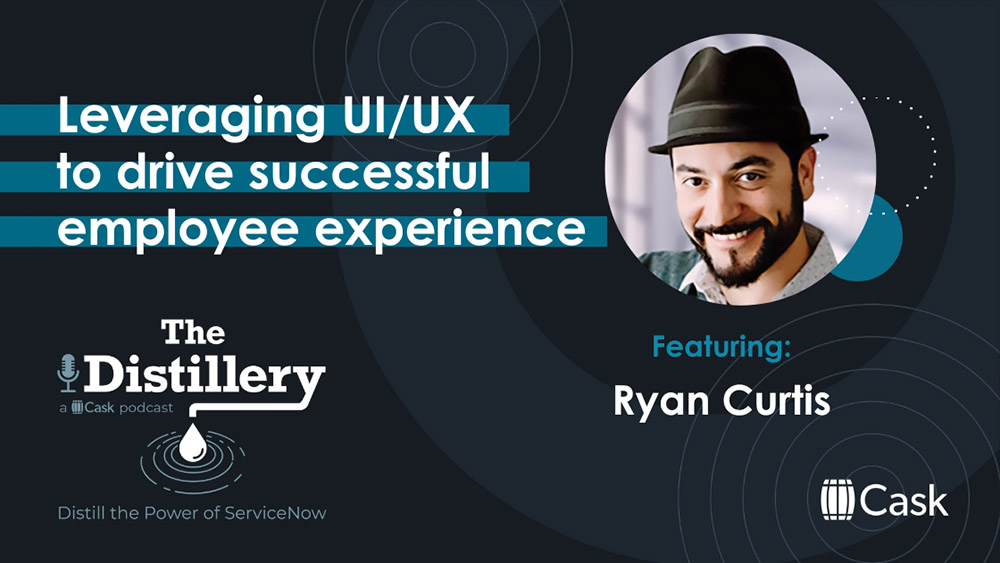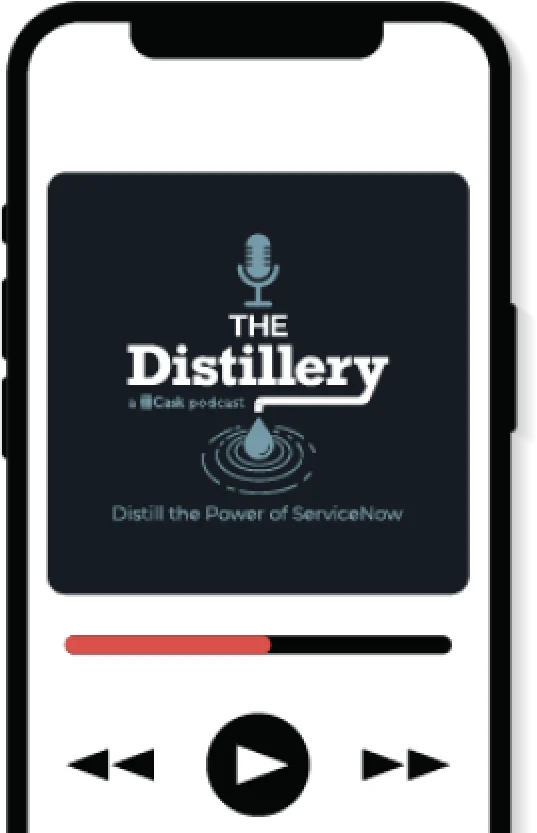Your Host:
Sean Dawson
Our Guest:
Ryan Curtis

Join Sean Dawson and Ryan Curtis, Cask's Senior UI/UX Designer, as they unravel the secrets to creating captivating employee portals that resonate with users. Dive into Ryan's methodology for understanding user challenges, mapping desired outcomes, and designing intuitive solutions. Discover invaluable tips on conducting user research, building personas, and validating designs through iterative testing. Explore the impact of consistency, accessibility, and visual appeal on user adoption and engagement. This episode is a must-listen for professionals seeking to elevate their employee experience and drive organizational success through exceptional UI/UX design.
Sean Dawson: Hello, and welcome to the Cask Distillery Podcast, where, once again, we unlock the potential of ServiceNow with expert insights and practical strategies, only here on the Cask Distillery Podcast. And today, we are going to be talking about leveraging UI and UX to drive successful employee experience.
And I have with me another very special guest: Ryan Curtis. And to give him a quick intro, Ryan is our senior UI/UX designer. He’s had extensive art direction experience—about 20 years of combined agency and freelance experience—under his belt. And Ryan has worked on some of our top 15+ clients. I think it’s probably quite a bit more than that now.
But thank you for taking time, Ryan, to jump in with us and talk about UI/UX and how we’re driving successful employee experience. Thank you so much.
Ryan Curtis: Yeah, my pleasure, Sean. It’s great to be here. I love talking about my work and all the great stuff Cask does. So, thanks for having me.
Sean Dawson: It’s awesome. And I love your work. I’ve got a chance to see a lot of Ryan’s work. For those of you who listen to the show regularly, you know I’m a client architect, so I work with all the different what we call “practices” and people that do the real work here. And it’s impressive. And what I want to start out with is what do you discuss with customers to be able to build a valuable UI/UX, first of all?
Ryan Curtis: Yeah that’s usually early in the process when we start having those conversations. And that’s really where it starts is conversations. And, in a nutshell, I would say to really understand what the challenges are that the customer’s facing and how to get them where they need to be is understanding the current state (where they’re at) and then understanding where they want to be, what is their end vision, where do they want to take this portal, and what kind of features and functions and what kind of things do they want to give to their employees.
So I think of myself as the trail guide. They know where they are and they know where they want to be, but they don’t really know how to get there. All the paths in between. I bring the experience and the knowledge, and I’ve tracked this path before with other customers. So that’s how I see it and see myself as that role. Just try to not boss them around but lead them to where they really want to be, not where I think they should be.
And a lot of that starts with just discussions/workshops. I really want to dig into pain points, really want to understand their frustrations first and foremost. It’s almost a therapy session where I’m just like, “Tell me all your problems. Tell me what’s not working, whether it’s on the fulfiller side or the requester, the employee side, whatever it is.” That’s not only valuable for me but my other teammates as well that work on the project, because they get a little bit of insight into workflows and other things that may affect their work stream. The biggest thing is to dig into their pain points.
And I also try my best to convey what the expectations are of my process and what they’re going to get from me. And I’m not going to solve every problem. I can’t do everything, but I try to lay that foundation to help them understand the big benefits, and really how UX and UI can enhance out-of-box ServiceNow. Out-of-box ServiceNow is great, but it can be so much better. It’s just that base level.
So I try to set those expectations early and just help them understand my world, because often they don’t. So I try to give them those visuals and help them understand what I do and how important it is for their user populace and their employees.
It’s not magic. It’s method. It really is. There’s no fairy dust or anything included. It’s a proven methodology used all over different industries.
Sean Dawson: Yeah. You said something that really—I know we at Cask all generally think this way, but it really touches my heart: making sure you’re an advisor. And some people can lord things over people and “No, this is the way to do it.” It’s more about what is the best for the client—where they’re at and what they’re doing. And along with that, how do we go from getting something like an idea all the way to validation faster?
Ryan Curtis: Yeah, we were seeing more of this where clients—and it’s great. You don’t want to boil the ocean. You don’t want to try to solve every problem all at once, but focus. Have a more focused effort to focus on a specific problem. Go from idea to solution faster. And that’s really where the agile methodology comes in on a larger scale, where you’re very dedicated to having a set of smaller problems that you can tackle one by one in a fast-paced, more focused, iterative solution rather than a more traditional waterfall solution, where you’re doing two-week sprints, and you’re going from workshops and requirements all the way up to an actual demo of a completed tool.
Embodying that agile methodology or incorporating some of those processes or working styles into actual organizational executions is important. Just being able to be more faster, a little more reactive, a little more innovative.
Other things I’ve seen work that really bring ideas to life faster is validation. We can create whatever you want, but until you test it with the people who are actually going to be using it, you don’t really know if what we’re doing is right. So a big part of that is validation.
And sometimes it’s difficult to get on people’s calendars. Everybody’s busy these days. It’s hard to identify testers and say, “Okay, these people would be great to test this, but we need more than a week to give them time to do that.” If there’s any way that organizations can have a little bit more of a council, like a representative from different parts of the org that can always be available to test new solutions and be aware of things that are happening and give input and feedback on these technologies and tools that the organization’s bringing to life. So the more you can expose that to people who are actually using it, I think, the better. Cause then you’re not just guessing, you actually are validating. And if you have a set group of people that are ready in the wings to get their eyes and ears and hands on those things. you can move a lot faster. And I believe we at Cask have an offering that’s similar to that: just a very short, dedicated, focused, innovation sprint really is, I think, is how we sell that.
So we do things just like it’s . . . yeah.
Sean Dawson: So, to the validation point we’re at now going from “I did a validation.” So once you get it in, the other thing that I’ve seen, and I know you’ve seen this too, or we see it at Cask as well, is the user adoption issues. The challenge to actually get users to the portal. We’ve done all this work. How do we get users actually to the portal in your opinion?
Ryan Curtis: I don’t wanna say that’s not my job; that’s definitely my job. But I think a lot of that also comes with OCM. Making people aware of what’s coming. Organizations doing a good job or preparing their people and communicating the benefits.
So I think OCM (organizational change management) has a significant part of the pie there to really drive adoption and get buy-in and find those change champions and identify those people and drive that awareness. Even lack of user engagement—things I’ve been talking about—interviews with people early in the design process, hearing what employees are saying, building out personas—snapshot representations of people and user groups—mapping and understanding their journeys. What does onboarding look like? What does requesting a new computer look like? What are these various workflows, and where are the drop offs? Where are the poor parts—the frustrating parts—of that process?
Because often, you don’t need to revamp the entire process. There’s usually just one or two parts in that process that are the pain points. So identifying those and being able to focus on those, you can make a significant improvement much faster instead of trying again to reshape the entire process that your workflows are using.
Other barriers to portal adoption, I would say accessibility and just poor visual styling. It can function great, but if it’s not easy to navigate or easy to read or use from page to page, or if there’s a lot of lingo that is just overly IT or HR jargon, it just creates that many more barriers. So, your goal is to meet the users where they are, using natural human language—words that people say—not overloading people with jargon, making things consistent on every page. The same content is found in the same area of the page from department to department. It’s not just the Wild West, where the IT page looks completely different than the HR page, looks completely different than the finance page. So the more consistency you can bring, it’s just such a smoother, more frictionless experience for users.
Sean Dawson: So you’re saying you don’t really want one page to look like a—and I’m dating myself here—like a MySpace page and then the rest of it looking like a ServiceNow page. You don’t want it going crazy. Yeah, totally get that.
And you mentioned, you got into this a little bit with accessibility, or you mentioned it. I wanted to take a moment and kind of highlight that. What is accessibility and why does it matter?
Ryan Curtis: Yeah, that’s a great question. That’s a big topic these days, especially, I think, since COVID. Now everybody is much more working on their machines, their laptops. And what accessibility is is it’s really taking intentional steps to removing barriers to consuming content for as many people as possible, including people who are maybe blind or colorblind, deaf or hearing disabled, or any other kind of disability. One in four people in the US are disabled. So that’s a huge percentage and factor.
So, organizations, they need to treat everybody equally. Adhering to government standards which is where accessibility has come now. It’s a government standard, different levels. But, there’s been a few cases when a company doesn’t intentionally adhere to those, they’ve been faced with massive fines. Lots of penalties and court charges or court cases, and that’s no fun for anybody. Nobody wants to face a discrimination case just because they maybe didn’t know or weren’t really educated as to why.
The bottom line is it matters at the bottom line: the money. But it’s also just treating everybody equal and making sure that your content—your information—is accessible to everybody. Those critical services, critical information that everybody needs.
Some of that lies in my court. And a lot of it lies in the developer’s court—in content publishing and content creation. Things like color, contrast, font size, even just page layout, information hierarchy. If you can imagine someone who’s blind using a screen reader and the screen reader goes up and down the page left and right, and if things just don’t make sense in terms of layout or labels, that’s very confusing to the user because it doesn’t make sense from an information hierarchy standpoint.
But then there’s also behind-the-scenes things—alt text, HTML tags, audio descriptions, closed captioning—a lot of things that I think people may take for granted but is critical for a lot of employees out there. So it is very important. And a lot of it is behind the scenes. You don’t really see it, but it’s highly effective, and it’s highly valuable, and it makes a great positive impact for all employees.
Sean Dawson: So in the last question I wanted to ask you, my background was graphic arts, as we discussed earlier, and I know UI/UX is visual, and sometimes people really need to actually see the art of the possible. I know we’ve got somewhere we can send them. Can you talk a little bit about that?
Ryan Curtis: Yeah, sure, Sean. We are just in the middle of creating this thing. We’re calling it the Demo Hub—the Cask Demo Portal Hub.
So basically what it is is it’s an e-commerce site, almost. You’re shopping around and looking at some of the work we’ve done. It’s very simple design of a site, but it’s somewhere you could go to interactively look at all the visual design and the portals we’ve done here at Cask. So it’s almost—
Envision a lot of case studies. Each page is a case study of one customer, and it has some information on what was their challenges, what were they facing, what was their issue with the platform. And then how did we come in and solve it. Bring them innovative thinking and solutions. And what were the results. Maybe if we have some metrics to showcase and say, “This made a great positive impact here,” or, “Smoothed out some things with employees over here.” We try to showcase the results as well, because that’s really what matters when it comes down to it.
But like you said, the great part is the visual stuff, the eye candy. Case studies are great to read about. The big wall of words can be interesting. But yeah, a picture can speak a thousand words. Really trying to be better at showcasing the great work we do. Cause I don’t think we do that enough on our website. So we’re trying to try to change that.
Sean Dawson: That’s great. That’s all the time we have for today. And thank you so much, Ryan, for taking time out of your busy schedule to join us. I do want to mention that we will have a link in the description to that resource that Ryan mentioned as soon as we can get it up. I do want to ask you, as always, that if you can like, subscribe—basically, give us suggestions, anything you want to see, because really we’re here for you as the listener, watcher, however, you’re consuming this. And for today, that’s it.
Thank you so much and take care. Bye bye.
We’re with you for what comes next
You're working in a rapidly shifting environment.
Global dynamics, AI advancements, heavy competition–the only certainty is change.
We get it. And we’re here to help you harness the full potential of ServiceNow to simplify transformation.
Let's navigate the future together.

Recent Episodes
We’re with you for what comes next
You're working in a rapidly shifting environment.
Global dynamics, AI advancements, heavy competition–the only certainty is change.
We get it. And we’re here to help you harness the full potential of ServiceNow to simplify transformation.
Let's navigate the future together.

Let’s Innovate Together!
Request a Complimentary Consultation from Cask.
Cask’s unparalleled expertise is ready to tackle your unique challenges and transform your aspirations into reality. We’ll listen to understand your requirements and offer a tailor-made approach that aligns with your strategic objectives.
Your journey to innovation is just a click away. Schedule your meeting with our Cask advisors and become part of the success story that defines your organization’s future.

Sign up for our Distillery Podcast
Stay up to date with the latest episodes







